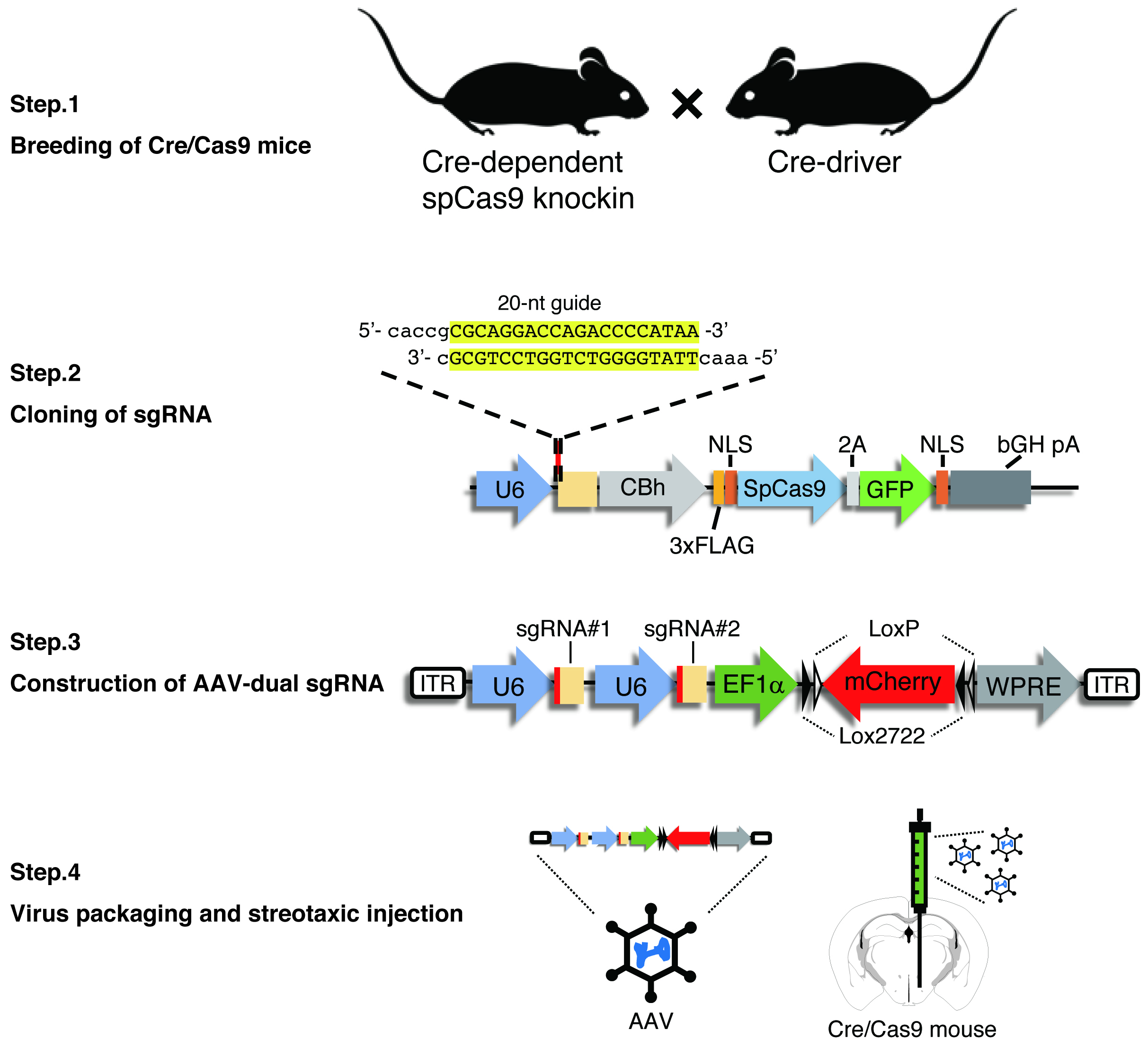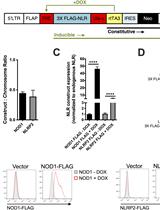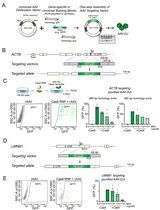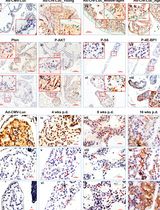- EN - English
- CN - 中文
Construction of Viral Vectors for Cell Type-specific CRISPR Gene Editing in the Adult Mouse Brain
用于成年小鼠脑组织的细胞特异性CRISPR基因编辑的病毒载体的构建
发布: 2019年08月20日第9卷第16期 DOI: 10.21769/BioProtoc.3334 浏览次数: 6866
评审: Arnau Busquets-GarciaValeria B Fernandez ValloneAnonymous reviewer(s)
Abstract
Recently developed gene editing technologies based on engineered CRISPR/Cas9 systems enables researchers to disrupt genes in a cell type-specific manner in the adult mouse brain. Using these technologies, we recently showed that the dopamine beta-hydroxylase gene in Locus Coeruleus (LC) norepinephrine neurons plays a vital role in the maintenance of wakefulness. Our method consists of four steps, (1) crossing Cre-dependent spCas9 knockin mice with a Cre-driver mouse line to express spCas9 in the target neural populations, (2) cloning of sgRNA, (3) construction of an AAV (adeno associated virus) vector expressing dual sgRNA, and (4) virus packaging and stereotaxic injection of the virus into the target brain area. Here, we describe a detailed protocol of AAV vector construction for cell type-specific CRISPR gene editing in the adult mouse brain. The method adopts a dual-sgRNA strategy for efficient disruption of the target gene. At first, a few different sgRNAs targeting the same gene are cloned into a plasmid expressing spCas9. After evaluation of the sgRNAs by a T7 endonuclease assay, the two most efficient sgRNAs are cloned in tandem into an AAV vector using the Gibson Assembly method.
Keywords: CRISPR/Cas9 (CRISPR/Cas9)Background
Interrogation of gene functions in specific cell subtypes in the brain remains a challenge. The conventional techniques such as RNAi-based methods lack cellular specificity and efficiency. On the other hand, recently developed gene editing techniques using the CRISPR/Cas9 system allows researchers efficient gene disruption in a cell type-specific manner. A research group led by Feng Zhang showed the disruption of multiple genes in the adult mouse brain by AAV-mediated delivery of sgRNA (Swiech et al., 2015). Also, the group established cre-dependent spCas9 knockin mice (Platt et al., 2014). In a recent study, we used an AAV vector carrying dual sgRNA to improve the efficiency of bi-allelic gene targeting (Yamaguchi et al., 2018). We here describe a protocol for the construction of dual sgRNA AAV vector (Figure 1).
Figure 1. Schematic representation of all the procedure. Our method consists of four steps: (1) crossing Cre-dependent spCas9 knockin mice with a Cre-driver mouse line to express spCas9 in the target neural populations, (2) cloning of sgRNA into the spCas9 expressing plasmid, (3) construction of an AAV vector tandemly expressing dual sgRNA, and (4) AAV packaging and stereotaxic viral injection into the target brain area.
Materials and Reagents
- Pipette tips
- 24-well plate (coated) (Thermo Fisher Scientific, catalog number: 142475)
- 1 ml plastic tube
- NEB10-beta Competent E. coli (New England Biolabs, catalog number: C3019)
- pX458 (Addgene, catalog number: 48138)
- pAAV EF1α DIO mCherry (Addgene, catalog number: 20299)
- BbsI-HF (New England Biolabs, catalog number: R3539)
- MluI-HF (New England Biolabs, catalog number: R3198)
- DpnI (New England Biolabs, catalog number: R0176)
- Alkaline Phosphatase, Calf Intestinal (CIP) (New England Biolabs, catalog number: M0290)
- Guide oligonucleotides (see Procedure A)
- Quick ligation kit (New England Biolabs, catalog number: M2200)
- Gibson Assembly Master Mix (New England Biolabs, catalog number: E2611)
- PrimeSTAR HS DNA polymerase (Takara, catalog number: R010)
- dNTP Mix 10 mM each (the mix of 10 mM of dTTP, dCTP, dGTP and dATP) (GenScript, catalog number: C01689)
- QIAquick Gel Extraction kit (QIAGEN, catalog number: 28704)
- QIAprep Spin Miniprep kit (QIAGEN, catalog number: 27104)
- Tris-EDTA, (1x Solution) (Fisher BioReagents, catalog number: BP2473)
- LB Broth EZMix Powder (Sigma, catalog number: L7658)
- LB Agar (Fisher BioReagents, catalog number: BP1425)
- Ampicillin (Gemini Bio-Products, catalog number: 400-130P)
- Primer to verify the cloning of sgRNA into pX458: 5’-gactatcatatgcttaccgt-3’
- Primer to verify the tandem cloning of sgRNAs into pAAV: 5’-actgacgggcaccggagcca-3’
- Primers for Gibson Assembly:
Primer S1: 5’-taggggttcctgcggccgcacgcgtgagggcctatttc-3’
Primer AS1: 5’-ataggccctctctagaaaaaaagcaccgactc-3’
Primer S2: 5’-tttttctagagagggcctatttcccatg-3’
Primer AS2: 5’-atccatctttgcaaagcttacgcgtaaaaaagcaccgac-3’Optional (see Procedure C)
- NIH3T3 cell (ATCC, catalog number: CRL-1658)
- AAV vector (pX458-sgRNA or pX458 empty as negative control )
- Primers: You can design the primers to amplify the target exons by CHOPCHOP (see Procedure C)
- PrimeSTAR HS DNA polymerase
- FuGENE6 Transfection Reagent (Promega, catalog number: E2693)
- DMEM (1x) (Gibco, catalog number: 11995-065)
- Fetal Bovine Serum (Corning, catalog number: 35-015-CV)
- Penicillin/Streptomycin (Gibco, catalog number: 15070-063)
- PBS, pH 7.4 (Gibco, catalog number: 10010-023)
- TrypLE Select (1x) (Gibco, catalog number: 12563-011)
- QuickExtract DNA Extraction Solution (Epicentre, catalog number: QE0905T)
- T7 Endonuclease I (New England Biolabs, catalog number: M0302)
Equipment
- Pipettes (Gilson, Pipetman classic P10, P20, P200)
- Centrifuge (Eppendorf, Centrifuge 5424)
- Incubator (VWR, incubating 5000IR orbital shaker)
- Thermocycler (Applied Biosystems, GeneAmp PCR system 2700)
- Electrophoresis chamber (Labnet, ENDURO GEL XL)
- (Optional) CO2 Incubator (Binder, CB 170)
- (Optional) Clean bench (Labconco, Purifier classII biosafety cabinet)
- (Optional) Centrifugation (Thermo Scientific, Soryall legend XTR)
Procedure
文章信息
版权信息
© 2019 The Authors; exclusive licensee Bio-protocol LLC.
如何引用
Yamaguchi, H. and de Lecea, L. (2019). Construction of Viral Vectors for Cell Type-specific CRISPR Gene Editing in the Adult Mouse Brain. Bio-protocol 9(16): e3334. DOI: 10.21769/BioProtoc.3334.
分类
神经科学 > 神经解剖学和神经环路 > 动物模型
分子生物学 > DNA > 基因表达
您对这篇实验方法有问题吗?
在此处发布您的问题,我们将邀请本文作者来回答。同时,我们会将您的问题发布到Bio-protocol Exchange,以便寻求社区成员的帮助。
Share
Bluesky
X
Copy link












